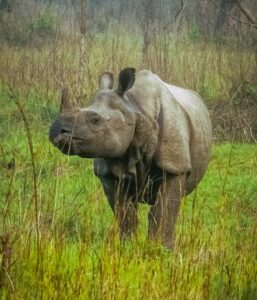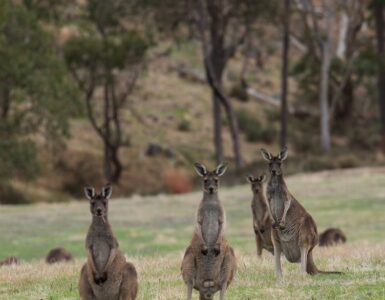The world’s largest coral reef system is the Great Barrier Reef in Australia; Yellowstone National Park in the USA, known for its geothermal features; and the Amazon Rainforest in South America, regarded as the largest tropical rainforest in the world – all these ecologically sensitive sites are not only natural wonders but are also identified under UNESCO World Heritage Sites.
UNESCO (United Nations Educational, Scientific and Cultural Organization) designates certain places worldwide as World Heritage Sites based on their cultural, historical, or natural significance.
When it comes to natural sites, these are areas recognized for their outstanding universal value in natural beauty, biodiversity, geological formations, or ecological significance.
There are more than 200 natural UNESCO World Heritage Sites around the globe, each with unique features and significance. India is also home to incredible biodiversity, including the world’s largest mangroves, alpine meadows, lush green forests, snow leopards, royal Bengal Tigers, one-horned Rhinos, and many others.
Here is a list of Natural UNESCO World Heritage Sites in India that you should put on your travel bucket list.
Great Himalayan National Park Conservation Area
Location: Himachal Pradesh.
The Great Himalayan National Park Conservation Area is Situated in the western part of the Himalayan Mountains in the northern Indian state of Himachal Pradesh.
The park covers an area of 1,171 square kilometers and was inscribed as a World Heritage Site in 2014 due to its outstanding universal value in biodiversity conservation. The park is home to diverse flora and fauna, including several endangered species such as the snow leopard, Himalayan brown bear, Himalayan tahr, and musk deer. It also supports a variety of plant species, including many medicinal plants.
The park encompasses a range of ecosystems, including alpine meadows, temperate forests, and glaciers, providing habitat for a wide array of species adapted to different altitudes and climatic conditions.
The Himachal Pradesh Forest Department manages the Great Himalayan National Park Conservation Area with support from various conservation organizations and local communities. Efforts are made to conserve the park’s biodiversity while promoting sustainable tourism and community livelihoods.
Regarding visitor experience, the park offers opportunities for trekking, viewing wildlife, and experiencing the natural beauty of the Himalayas. The park has several trekking routes and camping sites, allowing visitors to explore its pristine wilderness.
Kaziranga National Park
Location: Assam
Kaziranga National Park is a UNESCO World Heritage Site located in the state of Assam, India. It is renowned for its significant population of the Indian one-horned rhinoceros and other wildlife species.
Situated in the northeastern state of Assam, Kaziranga National Park covers an area of approximately 430 square kilometers. The Brahmaputra River borders it to the north and the Karbi Anglong hills to the south.


Kaziranga is home to a rich diversity of flora and fauna. Apart from the one-horned rhinoceros, the park is known for its large populations of Asian elephants, wild water buffalo, and Royal Bengal tigers. Other wildlife species found here include swamp deer, wild boar, sambar deer, and various species of birds, including migratory birds.
The park consists of grasslands, wetlands, and dense forests, providing diverse habitats for its wildlife. The tall elephant grass and marshy areas are characteristic features of the landscape.
Kaziranga National Park was declared a UNESCO World Heritage Site in 1985 due to its exceptional natural beauty and the importance of its biodiversity conservation efforts, particularly for the endangered Indian one-horned rhinoceros. Conservation efforts within the park include anti-poaching measures, habitat restoration, and community involvement in conservation initiatives.
Kaziranga is a popular tourist destination, attracting wildlife enthusiasts and nature lovers worldwide. Visitors can explore the park through jeep safaris, elephant safaris, and guided walks. The park offers wildlife viewing and birdwatching opportunities, allowing visitors to observe its diverse flora and fauna in their natural habitats.
Keoladeo National Park
Location: Rajasthan
Keoladeo National Park, formerly Bharatpur Bird Sanctuary, is a UNESCO World Heritage Site in the Indian state of Rajasthan.
Situated in the town of Bharatpur, Rajasthan, Keoladeo National Park covers an area of approximately 29 square kilometers.
The park is renowned for its avian diversity, particularly during the winter months when it becomes a major wintering ground for migratory birds. Over 370 species of birds have been recorded in the park, including both resident and migratory species. Some of the key bird species found here include waterfowl, waders, raptors, and passerines.
Apart from birds, Keoladeo National Park is also home to a variety of other wildlife, including mammals like spotted deer, sambar deer, nilgai (blue bull), wild boar, and small carnivores like jackals and foxes.
Keoladeo National Park is characterized by its wetland habitats, including shallow lakes, marshes, and grasslands. The park was originally a natural depression, which was artificially transformed into a wetland by the Maharaja of Bharatpur in the 18th century to serve as a waterfowl hunting ground.
Keoladeo National Park was designated as a UNESCO World Heritage Site in 1985 due to its importance as a wetland habitat for birds. The park is also recognized under the Ramsar Convention as a Wetland of International Importance. Conservation efforts within the park focus on habitat preservation, water management, and monitoring of bird populations.
Keoladeo National Park is a popular destination for birdwatchers, nature enthusiasts, and photographers. Visitors can explore the park on foot, bicycle, or cycle rickshaw, accompanied by trained guides. The best time to visit the park is during the winter months (November to February) when the migratory bird population is at its peak.
Manas Wildlife Sanctuary
Location: Assam
Manas Wildlife Sanctuary, also known as Manas National Park, is a UNESCO World Heritage Site located in the state of Assam, India.
Situated in the foothills of the Eastern Himalayas, Manas Wildlife Sanctuary spans an area of approximately 950 square kilometers. It is located in the northeastern part of India, near the border with Bhutan.
Manas is renowned for its rich biodiversity, including a wide variety of flora and fauna. The sanctuary is home to several endangered and vulnerable species, including the Bengal tiger, Indian elephant, Indian rhinoceros, wild water buffalo, and pygmy hog. It is also an important habitat for rare and endemic species of birds, such as the Bengal florican and the great hornbill.
The sanctuary comprises diverse ecosystems, including tropical moist forests, grasslands, and wetlands. The Manas River, which flows through the sanctuary, provides crucial water sources and supports a thriving ecosystem.
Manas Wildlife Sanctuary was designated as a UNESCO World Heritage Site in 1985 in recognition of its outstanding universal value and significance for biodiversity conservation. The sanctuary is also recognized as a Tiger Reserve, an Elephant Reserve, and a Biosphere Reserve, highlighting its importance for the conservation of iconic and endangered species.
Like many protected areas, Manas Wildlife Sanctuary faces various conservation challenges, including poaching, habitat degradation, and human-wildlife conflict. Efforts are underway to address these challenges through community-based conservation initiatives, anti-poaching measures, habitat restoration, and sustainable tourism development.
Manas Wildlife Sanctuary is open to visitors, offering opportunities for wildlife safaris, birdwatching, and nature walks. Visitors can explore the sanctuary on elephant-back safaris or in jeeps accompanied by trained guides.
Nanda Devi National Park
Location: Uttarakhand
Situated in the Chamoli district of Uttarakhand, Nanda Devi National Park encompasses an area of approximately 630 square kilometers.
The park is named after Nanda Devi, one of the highest peaks in India. It is renowned for its stunning alpine landscapes, including rugged mountains, deep valleys, and glaciers.
It is also recognized as a Biosphere Reserve, home to a diverse range of flora and fauna, including several endangered species such as snow leopards, Himalayan musk deer, and Asiatic black bears.
Nanda Devi National Park was established in 1982 and designated as a UNESCO World Heritage Site in 1988.
Access to the core area of Nanda Devi National Park is restricted, and permits are required for entry. However, the park’s buffer zone offers opportunities for trekking and mountaineering.
Valley of Flowers National Park
Location: Uttarakhand
Nanda Devi National Park and Valley of Flowers National Park are two adjacent UNESCO World Heritage Sites in the Indian state of Uttarakhand.
Valley of Flowers National Park is located near the town of Joshimath in the Chamoli district of Uttarakhand. It covers an area of about 87.5 square kilometers.
The park is renowned for its stunning floral displays, particularly during the monsoon season when the valley is carpeted with a variety of alpine flowers in full bloom. The valley is home to hundreds of species of flowers, including several endemic and rare species. Besides its floral diversity, Valley of Flowers National Park also supports a variety of wildlife, including Himalayan black bears, snow leopards, musk deer, and numerous bird species.
Valley of Flowers National Park was designated a UNESCO World Heritage Site in 2005 due to its exceptional natural beauty and biodiversity.
The park is open to visitors from June to October, with the peak flowering season between July and August. Visitors can explore the valley on trekking trails that offer breathtaking views of the surrounding mountains and waterfalls.
Sundarbans National Park
Locations: West Bengal (India) and Bangladesh
Sundarbans National Park is a UNESCO World Heritage Site located in the Sundarbans delta in the Indian state of West Bengal and neighboring Bangladesh.
Sundarbans National Park is situated at the mouth of the Ganges River delta, where it empties into the Bay of Bengal. It covers approximately 1,330 square kilometers in India’s Sundarbans region, while the entire Sundarbans mangrove forest, including the part in Bangladesh, is much larger.
Sundarbans is the largest mangrove forest in the world and is characterized by its unique tidal deltaic ecology. The park is named after the Sundari trees (Heritiera fomes), which are predominant in the area. The mangrove ecosystem provides a habitat for a diverse range of flora and fauna uniquely adapted to brackish water conditions.
Sundarbans is famous for its population of Royal Bengal tigers, which are adapted to the mangrove habitat and are known to swim in the saline waters. The tigers of Sundarbans are known for their unique behavior, including swimming and hunting in the mangrove swamps.
In addition to tigers, Sundarbans National Park is home to various other wildlife species, including saltwater crocodiles, spotted deer, wild boars, macaques, and numerous bird species. The park also supports diverse marine life, including fish, crustaceans, and mollusks.
Sundarbans National Park was designated a natural UNESCO World Heritage Site in 1987 to recognize its exceptional natural beauty and biodiversity. The park is also recognized as a Biosphere Reserve and is protected by the Sundarbans Tiger Reserve.
Sundarbans National Park attracts tourists worldwide who explore its unique mangrove ecosystem, observe wildlife, and take boat cruises through the deltaic channels. Tourists can also visit nearby villages to experience the local culture and way of life.
Western Ghats
Locations: Gujarat, Maharashtra, Goa, Karnataka, Kerala, and Tamil Nadu.
The Western Ghats is one of the world’s eight “hottest hotspots” of biological diversity.
The Western Ghats is a mountain range that runs parallel to the western coast of the Indian peninsula, spanning approximately 1,600 kilometers in length and covering parts of the states of Gujarat, Maharashtra, Goa, Karnataka, Kerala, and Tamil Nadu.
The Western Ghats, known as the Sahyadri Mountains, is renowned for its incredible biological diversity and endemic species. It is home to a wide variety of flora and fauna, including thousands of plant species, hundreds of bird species, and numerous mammals, reptiles, amphibians, and fish. Many species in the Western Ghats are endemic, meaning they are found nowhere else.
The Western Ghats is considered one of the world’s biodiversity hotspots due to its high species concentration and endemism. The region is crucial in maintaining ecological balance and providing ecosystem services such as water catchment, carbon sequestration, and climate regulation.
In addition to its natural significance, the Western Ghats is also rich in cultural heritage, with indigenous communities and traditional knowledge systems that have coexisted with the natural environment for centuries. The region is dotted with sacred groves, temples, and cultural landmarks that reflect the deep connection between people and nature.
The Western Ghats was inscribed as a UNESCO World Heritage Site in 2012 to recognize its outstanding universal value and significance for biodiversity conservation. Several protected areas and reserves have been established within the Western Ghats to safeguard its biodiversity, including national parks, wildlife sanctuaries, and biosphere reserves.
Khangchendzonga National Park
Location: Sikkim
Khangchendzonga National Park is another natural UNESCO World Heritage Site located in the northeastern part of India, in Sikkim. It covers an area of approximately 1,784 square kilometers and extends from the lowlands of the subtropical zone to the cold, rugged terrain of the Himalayas.
The park is renowned for its rich biodiversity, including various flora and fauna. It is home to several endangered and endemic species, including the snow leopard, Himalayan black bear, red panda, and Himalayan blue sheep. The park also supports diverse ecosystems, including alpine meadows, temperate forests, and glacial landscapes.
Khangchendzonga National Park holds cultural significance for the indigenous communities of Sikkim, particularly the Lepcha and Bhutia tribes. The park is named after Mount Khangchendzonga, the third-highest peak in the world, which is considered sacred by the local people. The park’s diverse landscapes are also dotted with numerous monasteries, sacred sites, and cultural landmarks.
Khangchendzonga National Park was designated a UNESCO World Heritage Site in 2016 to recognize its outstanding universal value and significance for biodiversity conservation. The park is also recognized as a Biosphere Reserve and is protected by the Khangchendzonga Biosphere Reserve Authority.
Khangchendzonga National Park is a popular destination for trekking and ecotourism, attracting adventurers and nature enthusiasts worldwide. The park offers several trekking routes that provide breathtaking views of the Himalayan peaks, pristine forests, and alpine lakes. Visitors can also experience the unique culture and hospitality of the local communities.






Add comment